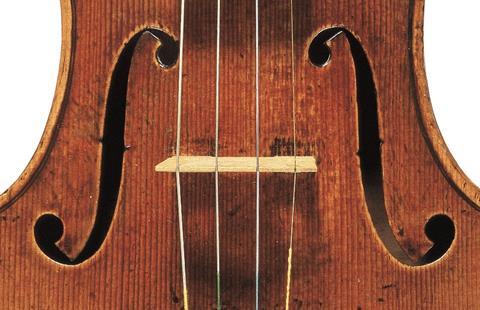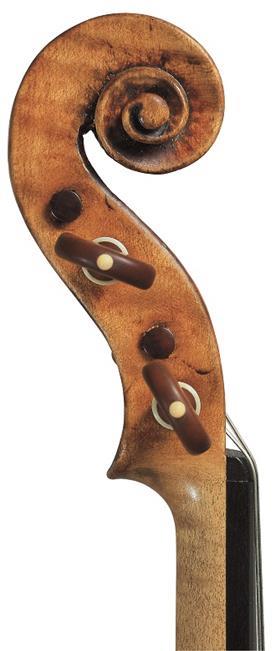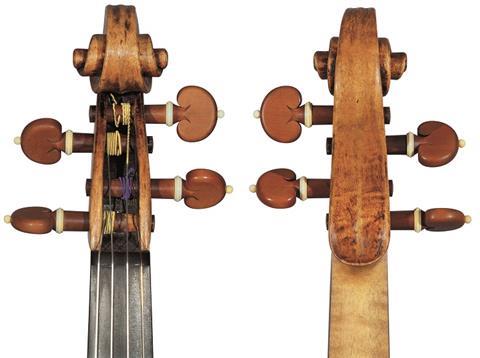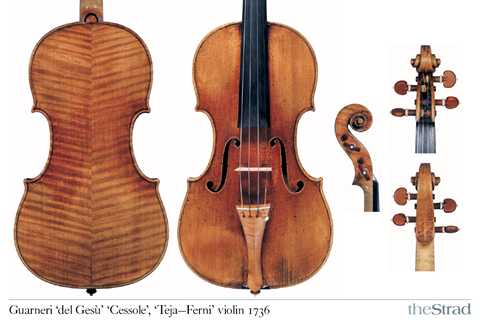Although Guarneri ‘del Gesù’ is best known for his wild, unruly later masterpieces, this 1736 violin reveals his softer side, as Carlo Chiesa explains in this focus on a Strad poster instrument first published in the July 2010 issue

As a violin maker, Giuseppe Guarneri ‘del Gesù’ was a genius. When he died, in October 1744, he was just a few months older than 46. Stradivari lived for twice as long, and it is tempting to wonder what Guarneri would have achieved had he lived as long as this other great master. Guarneri’s accomplishments are all the more impressive when one considers that he spent less than half of his life making violins. Very few instruments – if any – are attributed to him before 1727, and legal documents suggest that in the late 1720s he was still employed in a trade completely unrelated to lutherie. This means that he was perhaps only engaged in making instruments for 15 years or so in total. And yet these last 15 years of his life were very productive: from the number of instruments still in existence today – and allowing for a credible number of lost instruments – it is safe to assume that he produced an average of twelve to 15 per year.
The continuous evolution of the maker’s work is evident in his instruments. He experimented untiringly to find original solutions for many of the functional aspects of his violins, and in turn these breakthroughs paved the way for even more remarkable and unexpected innovations. With Guarneri I always feel a sense of quick movement – his violins are never final. Each one is a sort of new experiment, showing a continuous development, a restless search for something different, something better.
Guarneri’s earliest instruments do not have a particularly unusual appearance. In fact, these instruments are strongly linked to the Cremonese tradition. This is evident everywhere, starting from the patterns he used. The outline of ‘del Gesù’ violins is consistent throughout his career, although the look of the instruments changes a lot, primarily due to the shape of the corners. This is an important detail, with consequences for the archings and sounding properties of the instrument, but one that can still be altered without changing the mould on which one works: the shape of the corners depends upon the way the blocks are cut, and the blocks are newly glued to the mould and freely shaped for every new instrument. In his initial period of production, Guarneri did not cut the corners as short and open as he was to do in the following period. So, while maintaining the dimensions and proportions of his personal outline in the top, centre and lower bouts, in their general contour the first violins look quite different from the later ones, and are not that far removed from those of Stradivari. It is only in the extremely idiosyncratic instruments of Guarneri’s final years that his reputation as an eccentric can be justified. But for a long part of his working life, he remained in the mainstream of the tradition, taking ideas from his competitors while at the same time influencing them – he perhaps even influenced the Stradivaris. It is enlightening, for instance, to study how Guarneri developed his f-holes, considered a cipher of his style: each time he changed something from the preceding one. And for a period there is some similarity between his patterns and those of Stradivari. But if these two makers used different methods to place the f-holes on their instruments, it is Guarneri who remained faithful to the traditional method going back to the Amatis.
The main character of the violin is an appearance of delicacy, a trait that is generally unexpected for ‘del Gesù’
Guarneri ‘del Gesù’ made the ‘Cessole’, ‘Teja-Ferni’ violin during his period of full maturity. It bears a label dated 1736, and the character of the instrument fits perfectly with his style in that year. The label appears to be original, and the wording is the usual ‘Joseph Guarnerius fecit/ Cremone anno 1736’, with a cedilla under the e and the cross above the IHS trigraph on the right. As often happens, the label is quite small, the paper cut very close to the printed letters. The last two figures of the date are handwritten but still clearly readable.
The main character of the violin is an appearance of delicacy, a trait that is generally unexpected for ‘del Gesù’, but which is often found in his instruments before his later period. The body of the violin is a little small, a few millimetres shorter than a standard Stradivari. This is a common size for Guarneri, who consistently made violins with a body length of under 35.5cm. The stop length is also short, and the bridge has been placed a couple of millimetres below the f-hole nicks in order to extend it. Traces on the soundboard show that the bridge has been moved to various positions, both above and below the present setting.
The belly is made of two matched pieces of spruce perfectly sawn on the quarter. The grain is straight, with virtually no imperfections. However, it is quite irregular – initially narrow alongside the joint, it widens, then tightens, then widens again close to the edges of the lower bouts. The winter rings are pronounced. This wood is so similar to that used in other violins from this period – namely the ‘Plowden’ and the ‘d’Egville’ – that it appears to have been taken from the same log.
The violin’s condition is good: there are some tiny and barely visible repairs under the treble foot of the bridge, and small patches of the edgework have been doubled. The belly corners are small and worn, and all appear to have been altered. The purfling is fine and elegant, and is set quite close to the edges. The black outer strips are perfectly stained. In the corners the mitres are exquisitely finished and also match each other to perfection. The cut of the mitres and the fact that there is no space left between the end of the stings and the chamfer of the edge suggest that the corners were originally much longer, but it is now virtually impossible to imagine their original shape and length. In the area of the right upper corner several marks bear witness to a few unfortunate bow strokes. The varnish is worn, but there are still traces in the C-bouts, where it is of a warm red colour.

A very fine craquelure adds a touch of softness where the varnish has remained slightly thicker. The archings are consistent with those commonly found in Guarneri’s violins of this period. The lowest point is immediately inside the purfling, but the rise towards the centre of the instrument is long and well planned. The same pattern is found in the C-bouts area, where the archings outside the f-holes present a relaxed concavity, made more evident by the pronounced height of the arching in this area. The soundpost has distorted the arching slightly so it is possibly quite different from its original form. The f-holes are very attractive. Each is different, but they still show some attention to symmetry. The difference comes mainly from the wings, suggesting that the method used by Guarneri to place the patterns on the soundboard left some room for manoeuvre. In fact, the bodies are quite similar and elegant, based on the perfectly balanced design Guarneri used consistently until his last two or three years. The f-holes are cut with a strong knife movement, and there are irregularities where the maker went against the fibre. These small gaps are mostly found in places where one expects to have difficulties if one uses the knife with the right hand, mainly in the top part of the upper lobe of the bass f-hole, and the inside of the bottom part of the right f-hole. They are slightly undercut, the inside face wider than the external. The eyes are small, particularly the lower ones, and are perfectly round. The shape of the wings is typical of the work of Guarneri in this period and reminiscent of what other makers, including Stradivari, were doing – they are broad enough, but the main impression is of a distinct widening towards the end. The difference in their slant gives an extra appearance of asymmetry, but the final result is pleasant.
The ribs and back show the extra effort that Guarneri made to pick extraordinarily fine maple. Each part is made from wood with an extremely narrow growth structure and marked by a deep and regular flame. This flame is slightly broader on the back. The lower two-piece rib, which is cut at the end button, was probably originally fashioned from one continual piece. The same is also true of the top ribs. The rib corner joints are made in the typical Cremonese style, with the C-ribs glued first to the blocks, tapered to a fine edge and covered by the external rib. The joints are noticeably worn, but it is still possible to see some traces of black colour, suggesting that they were originally painted. The flame direction is unusual: the lower ribs and the C-ribs run in one direction, while the upper ribs go in the opposite direction. However, this is often the case with instruments by Guarneri: the same is found on the 1740 ‘Heifetz’ violin and in many others. The ribs were carefully bent, but Guarneri had a slight problem with the left centre bout. He probably hollowed the block a fraction too deep, so that as the rib was glued in place a flat bulge was left that extends over the three centimetres immediately adjacent to the block. Although on close examination this bulge is evident on the rib, Guarneri corrected this mistake with the outline of both back and belly.

The back is spectacular, with its broad and deep flame extending upwards from the central joint. The archings match the style of those of the top: they rise regularly and sweetly, starting immediately inside the purfling, a pattern consistently found in every part of the back, including the C-bouts, where the channels are obviously more pronounced than in the upper and lower bouts, but still remain soft and not at all sharp. The edges are thin, perhaps due to replaning after restorations. The corners are very short and small, but they are also very worn. As with the soundboard, the mitres of the purfling are carefully realised and give a touch of class to the already attractive whole of the corners. In the lower left corner there is a knife cut clearly visible, extending beyond the end of the purfling: while the mitres of the actual purfling divide the corner equally, this mark strongly tends towards the C-bouts. Evidently, Guarneri made adjustments while working in order to reach the results he wanted. As with the ribs, the back is cleanly finished and no marks have been left by tools. The only possible exception are some light and wide scratches in the area of the lower left corner. It is possible, however, that these marks were inadvertently left by a player. In backs of instruments by Guarneri it is usually possible to see the positioning pins used to locate the back to the endblocks. On the top button a large plug outside the purfling fills whatever was there originally, but at the lower end there is no trace of a pin. It is possible that the pin was completely covered by the purfling, but on very close inspection it appears that the edge has been altered in a masterly restoration, which would explain the absence of the pin. The dorsal pin is clearly visible and is placed exactly in the same position as in all the other violins of 1735–6 that I am aware of.

The head is of maple with a very fine grain and a lighter flame than that of the back. It is very similar to other contemporary Guarneri scrolls and, as always in this period, shows the style of the father of Guarneri ‘del Gesù’, Giuseppe ‘filius Andrea’. The peculiar shape of the eye, with a relatively wide comma, is common to other scrolls by ‘filius Andrea’, as is the irregular development of the volute, mainly following the saw cuts that define the first turn and the throat. The turns were finished with radial gouge strokes, still clearly visible, and gouge marks are also evident in the vertical walls. The fluting is regular but not deep, particularly in the chin. However, attention was paid to extending the channelling to the end of the chin. The head is particularly worn, and this perhaps softened original irregularities. Nevertheless, I have the feeling that this scroll was more carefully finished and cleaned than others from the same period. The pegbox has thin walls but is of the usual generous width, leaving enough room to insert strings into the pegs. Despite some small differences in the archings of the soundboard, the ‘Cessole’, ‘Teja-Ferni’ violin is strikingly similar to two famous instruments dated 1735 – the ‘d’Egville’ and the ‘Plowden’. These three violins are all included in the list of instruments the Hills picked as their favourite examples of the maker’s craftsmanship, and show the consistency of his work in this period. They also show that he was not a particularly idiosyncratic maker at this time; on the contrary, he appears to have had a methodical working process that allowed him to maintain a very high level of quality.
The ‘Cessole’, ‘Teja-Ferni’ has a long history, starting with a somewhat legendary passage through the hands of Jean-Baptiste Vuillaume. Vuillaume sold the fiddle to Count Cessole of Nice, an amateur instrumentalist who was a close friend of Nicolò Paganini. Indeed, Paganini died in the count’s villa, and it was Cessole who took care of Paganini’s body when it was refused burial in consecrated ground due to popular stories about Paganini’s relationship with the devil. Later, the violin came into the possession of Virginia Ferni, a young virtuoso who performed in a duo with her sister Carolina. Virginia married a Mr Teja, a banker from Turin, and it was in the Italian city that Alfred Hill saw the instrument for the first time. It was later sold in Russia, came back to western Europe, and in 1919 it crossed the Atlantic where it was acquired by the well-known collector Felix P. Kahn. In 1921, it was bought by a young player, Amy Neill, a pupil of Leopold Auer. She kept it for only a short time, and in the decades that followed it passed through the hands of various American dealers, collectors and players. In 1972, the violin became the property of Fritz Rychel and came back to Europe, and after a few years it was bought by the American collector, Herbert Axelrod. It is now part of one of the most distinguished private collections of violins in Italy.
Photos by Ester Passiatore




































No comments yet